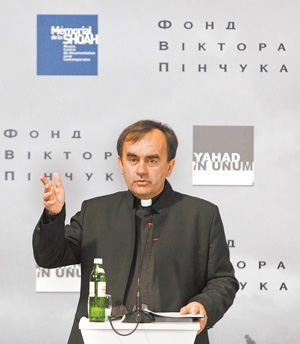A land that never sleeps
The Ukrainian Home is hosting an exhibit, “The Holocaust by Bullets: Mass-Scale Shootings of Jews in Ukraine in 1941-44,” as part of the program devoted to the 70th anniversary of the Babyn Yar tragedy
“The Holocaust by Bullets” is a little strange title because it specifies the instrument of killing: this universally-known catastrophe is of such a scale that it does not seem to matter whether people were killed by gassing or by a gunshot.
The answer was in the words of one of the speakers at the opening ceremony: in reality, the world still knows very little about what was going on in Ukraine during the Nazi occupation; the horrors of Auschwitz or Buchenwald seem to have overshadowed the Babyn Yar slaughter. Meanwhile, the Holocaust on this country’s territory claimed an estimated 1,400,000 to 1,600,000 human lives – at least a half of the Soviet Jews and about a fourth of all the European Jews who were massacred. In August 1941 alone, the so-called Einsatzgruppen killed 61,000 people in Ukraine – 910 every day, 82 every hour.
The exhibit, which has already been displayed in Paris and New York, is supposed to supply more statistical facts. The form is all too traditional: stands with texts and photos, video monitors, and original artifacts under glass. Yet it is impossible to go through this all even in a quick step and remain indifferent.
The exposition is detailed and carefully documented evidence of what was going on in this country 70 years ago. It tells the prehistory, i.e., the life of the Jewish community in Ukraine between the two world wars, analyzes the structure of the Nazi race destruction machine, shows the filmed or written testimony of those who saw executions or miraculously survived. The photographs show soldiers sorting the clothes of those executed in the Babyn Yar ravine and SS men killing children with a coup de grace against the backdrop of dead adults. One can see under the glass the cartridges and weapons with which women, children, the elderly and the infirm were indiscriminately killed.
A very representative opening ceremony featured all those who were involved in the organization of the exposition, including President of the French Memorial to the Shoah, Baron Eric de Rothschild; Viktor Pinchuk, head of the foundation named after himself; the Israeli, French, German, US, and British ambassadors, well-known historians and experts, but a French Catholic priest, Father Patrick Desbois, was undoubtedly the star attraction.
The Germans deported his grandfather to a concentration camp in Rava-Ruska near Lviv. Father Patrick said in his speech: “Granddad said to me: ‘It was terrible in the camp. There was nothing to eat and drink. But it was still worse outside it.’ I learned later that what was outside it was Ukraine.”
Patrick Desbois is the co-founder and president of Yahad-In Unum (“Together”) which has been doing archival and archeological research and collecting eyewitness evidence of mass-scale shootings in Ukraine. They come to our God-forsaken provinces, from village to village, asking old people if they saw any shootings of the Jews, Gypsies, partisans, and Soviet prisoners-of-war. “The Holocaust by Bullets” is based on this evidence. The Ukrainian Home also hosted the launching of the Ukrainian translation of Father Patrick’s book Porteur de memoires: sur les traces de la Shoah par balles that won the National Jewish Book Prize in 2008. The book contains the same photo documents and dialogues with the elderly Ukrainians who saw what is outside any idea of human cruelty.
When I asked Rev. Patrick Desbois how we should fight against anti-Semitism and racism which, unfortunately, also run riot on our land in spite of all the bitter historical experience and common sense, he answered: “Only by way of education. Only by telling about this.”
Within the month that “The Holocaust by Bullets” is held, there will be a lot of excursions and lectures for school and college students. Children will hear the truth about the most horrible tragedy, comparable to the Holodomor, on the Ukrainian soil and take it to their families. Will their fathers, mothers, sisters, brothers, and friends want to hear this truth?
The exhibit’s last photo was taken near Simferopol at the place of a mass-scale execution during the occupation. A common Crimean plain on which an elderly man is walking, and verses above the picture.
A Krymchak girl named Dora was 8, when she was shot dead near Sinferopol. Many years later her sister composed the following lines:
There is a land,
A land that never sleeps.
And when the wind blows,
Listen attentively:
it is still crying
In a terrible nightmare.
There is a land that
never sleeps…
It can see neither the stars
Nor darkness.
Look well: it still preserves
The features of its closest
relatives.
It spreads out,
more tender than fluff,
Beneath my feet…
It spreads out,
more tender than fluff,
Beneath my feet.
It really blesses me.
Nobody else has ever
Helped me as it has.
It is warm to touch,
More tender than fluff,
But it is harder than granite!
There is a land that
never sleeps…
The last witnesses of the Shoah
Will die sooner
than in five years,
Leaving behind just
The land that never sleeps.






